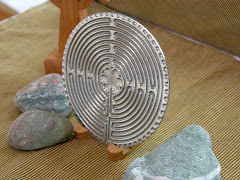About 2-1/2 years ago, the West Ohio Conference Lay Ministry Academy class of 2007 held its next to last weekend session prior to "graduating." I think back in a bittersweet way on those times at the Procter Center (near Midway, OH). About 20 of us started the program in class 3, which began a few years earlier as a lay leadership training series and was, theoretically, to become the basis of the certified lay minister "position" put into the Discipline in 2004. A few folks dropped out for personal reasons. A least one person found that the scope of the training was not the best fit for their personal faith journey. All of us who finished got to the end of the 2-year process and said, now what?
All of us felt a call to be more intentionally part of the United Methodist Church in a more formal way. For some, the call was to a particular ministry or project. For one, the LMA experience led him to pursue a local pastor license. LMA became for me the discernment time that culminated in coming to MTSO. Clear to me was that all of us in LMA wanted to be used in some way by the church for the glory of God and the good of God's people.
I fully intended to pursue certification back then, although the West Ohio Conference had no idea what certification would mean and what they would do with us. The final version of certification requirements came out after we finished, so in order to set ourselves up for certification the class members of 2005, 2006 and 2007 who wanted to pursue certification attended a make-up class on polity and completed our classroom requirements. I did so, even though my plans were changing for a variety of reasons. I told my friends at this session that I was entering seminary.
The politics of the certified lay minister designation soured me, for a time, on the Conference's perception of lay leadership. They supported LMA on the surface; I saw little genuine desire to tap this potential resource. George Howard was an exception. He was, and perhaps still is, a proponent of the program. Clergy, however, seem to just wish such an idea would go away. I remember one meeting (place and function withheld) where persons in authority discussed local use of certified lay ministry and the final statement was, "we're not going to appoint these people." The Discipline says that lay ministers can be appointed by the DS within a district. I had already declared my intent to serve eventually as an elder or deacon and had declared that I was not pursuing CLM standing, so I bit my tongue. CLM is meant to be a partner in team ministry under the supervision of the pastor in charge and the DS, so I didn't (and still don't) see a problem with using my friends from LMA if they get certified.
I had some folks ask me why I couldn't get certified and pursue my MDiv. No real reason other than, in their infinite wisdom, the Conference said a CLM must also be a lay speaker. Being a lay speaker wasn't a requirement when I entered LMA and after exploring this requirement, I decided it wasn't worth pursuing. After all, "we aren't going to appoint these people" anyway. God had called me in other directions, so I went where God called.
I feel for the Conference staff and District staffs who have had to wrestle with lay ministry. After all, General Conference created the "position" and didn't give any guidelines for years. CLM seems to be, intentionally or not, set up to conflict with Lay Speaking.
Without knowing exactly what was possible, those of us in the program pondered the what ifs of lay ministry and dreamed of how we might serve. I wonder how many of the approx 70 people who entered the first 3 classes of LMA were disappointed to find that they had dreamed things that just were not going to come to pass.
I could be wrong on this, but, to my knowledge, nobody has been certified as a CLM in West Ohio. Rather than whither? the operative word seems to be wither.
I wonder if other conferences have done any better? I hope so.
Subscribe to:
Post Comments (Atom)







No comments:
Post a Comment